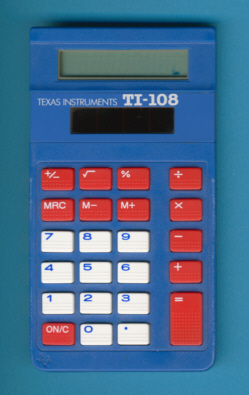
DATAMATH CALCULATOR MUSEUM
 |
DATAMATH CALCULATOR MUSEUM |
Texas Instruments TI-108
| Date of introduction: | 1986 | Display technology: | LCD |
| New price: | ($5.95 in 1988) | Display size: | 8 |
| Size: | 4.6" x 2.5" x
0.40" 116 x 64 x 10 mm3 |
||
| Weight: | 1.6 ounces, 44 grams | Serial No: | |
| Batteries: | n.a. | Date of manufacture: | mth 08 year 1988 |
| AC-Adapter: | Origin of manufacture: | Taiwan (C) | |
| Precision: | 8 | Integrated circuits: | Sharp LI3135MS |
| Memories: | 1 | ||
| Program steps: | Courtesy of: | Mark Bollman |

![]()
 Texas
Instruments introduced the TI-108 in 1986 as a slightly modification of the TI-1706
II. While the design and even printed circuit board (PCB) of the two
calculators are identical, sports the TI-108 a [+/-] key instead the [AC] key
found with the TI-1706 II. The successor of the TI-1706 II, called TI-1106,
is 100% identical with this early TI-108.
Texas
Instruments introduced the TI-108 in 1986 as a slightly modification of the TI-1706
II. While the design and even printed circuit board (PCB) of the two
calculators are identical, sports the TI-108 a [+/-] key instead the [AC] key
found with the TI-1706 II. The successor of the TI-1706 II, called TI-1106,
is 100% identical with this early TI-108.

 Dismantling
this first generation TI-108 reveals with the S32B-II 1K designation on the printed circuit
board (PCB) a hint to its contract
manufacturer. It seems to be a design of Kinpo
Electronics, Inc., manufactured in their
Cal-Comp
Electronics plant.
Dismantling
this first generation TI-108 reveals with the S32B-II 1K designation on the printed circuit
board (PCB) a hint to its contract
manufacturer. It seems to be a design of Kinpo
Electronics, Inc., manufactured in their
Cal-Comp
Electronics plant.
We started compiling a list of the PCB-Marks on calculators manufactured by OEMs for Texas Instruments.
Learn more about the Date
codes used with Texas Instruments calculators. This calculator sports the
Date code C-0888, in the same month production of the calculator was started
with Inventec Corporation, too.
Texas Instruments updated the design of its "Lifestyle" calculator
line mid of the 80s to a slightly smaller form factor and as a consequence the
appearance of the next TI-108 generation changed to the
design most American elementary students know even today.
Please find a detailed overview of the different hardware versions of the TI-108 calculators between 1988 and 2016 here.
Texas Instruments was always listening for the demands of the classroom. Read some guidelines how to select the right calculator to ensure long-term satisfaction:
| • Solar Power: Eliminates the need for batteries. The TI
ANYLITE™ technology allows operation even in low light. • Durability: Plastic keys are tougher and more tamper-proof than rubber keys. An extra window protects the LCD display and the solar cells. • Keyboard: Color coding helps children quickly identify functional key groupings. Large, well spaced keys are easier to find and press. • Packaging: With a convenient storage caddy 10 or even 30 calculators are grouped together. • Functions: Choose a model with only the specific functions you need. Unnecessary functions clutter the keyboard and may impede a student's understanding of the concepts. |
If you have additions to the above article please email: joerg@datamath.org.
© Joerg Woerner, June 7, 2009. No reprints without written permission.